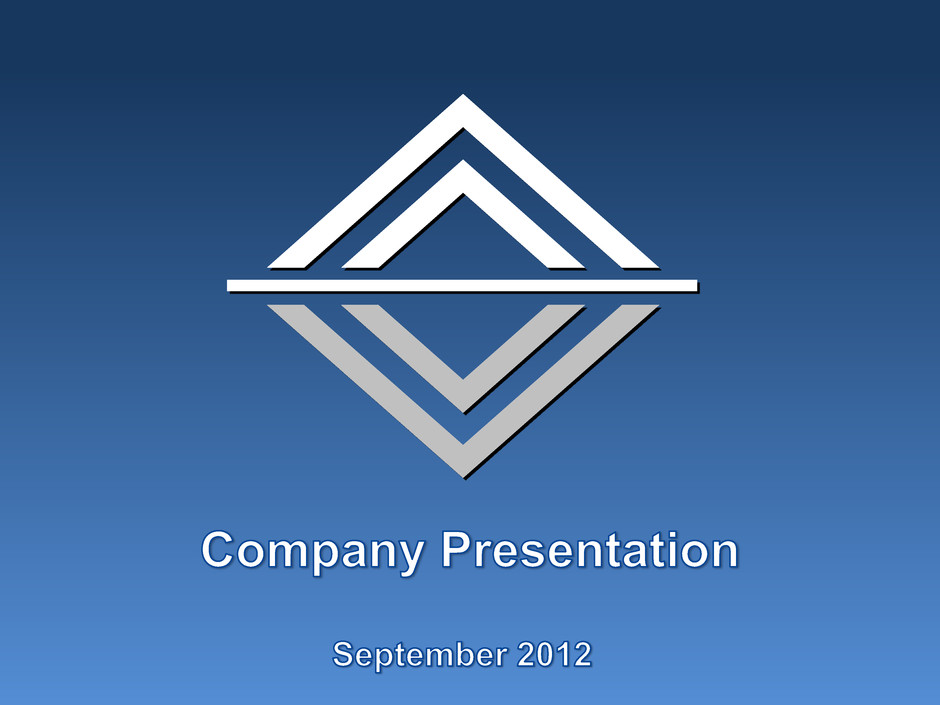Attached files
| file | filename |
|---|---|
| 8-K - 8-K - ASHFORD HOSPITALITY TRUST INC | investorslideshow9252012.htm |
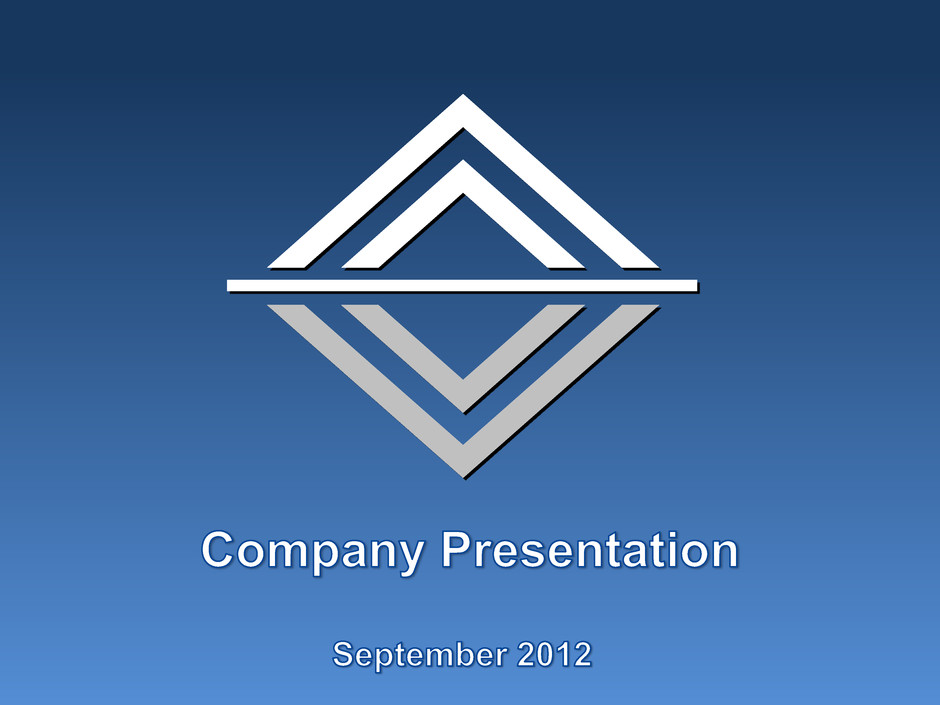
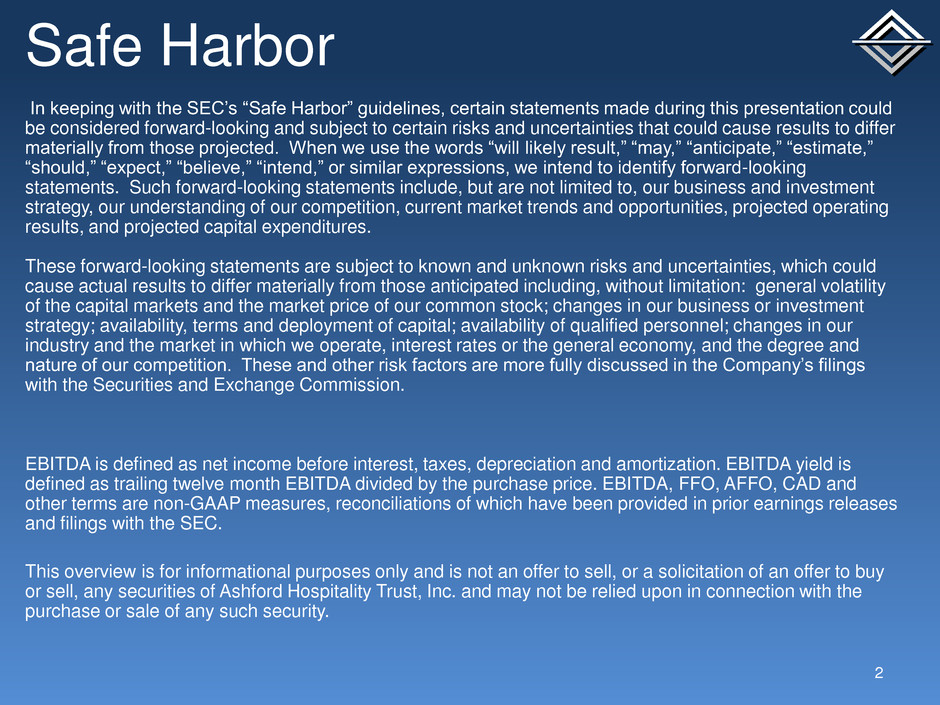
Safe Harbor In keeping with the SEC’s “Safe Harbor” guidelines, certain statements made during this presentation could be considered forward-looking and subject to certain risks and uncertainties that could cause results to differ materially from those projected. When we use the words “will likely result,” “may,” “anticipate,” “estimate,” “should,” “expect,” “believe,” “intend,” or similar expressions, we intend to identify forward-looking statements. Such forward-looking statements include, but are not limited to, our business and investment strategy, our understanding of our competition, current market trends and opportunities, projected operating results, and projected capital expenditures. These forward-looking statements are subject to known and unknown risks and uncertainties, which could cause actual results to differ materially from those anticipated including, without limitation: general volatility of the capital markets and the market price of our common stock; changes in our business or investment strategy; availability, terms and deployment of capital; availability of qualified personnel; changes in our industry and the market in which we operate, interest rates or the general economy, and the degree and nature of our competition. These and other risk factors are more fully discussed in the Company’s filings with the Securities and Exchange Commission. EBITDA is defined as net income before interest, taxes, depreciation and amortization. EBITDA yield is defined as trailing twelve month EBITDA divided by the purchase price. EBITDA, FFO, AFFO, CAD and other terms are non-GAAP measures, reconciliations of which have been provided in prior earnings releases and filings with the SEC. This overview is for informational purposes only and is not an offer to sell, or a solicitation of an offer to buy or sell, any securities of Ashford Hospitality Trust, Inc. and may not be relied upon in connection with the purchase or sale of any such security. 2
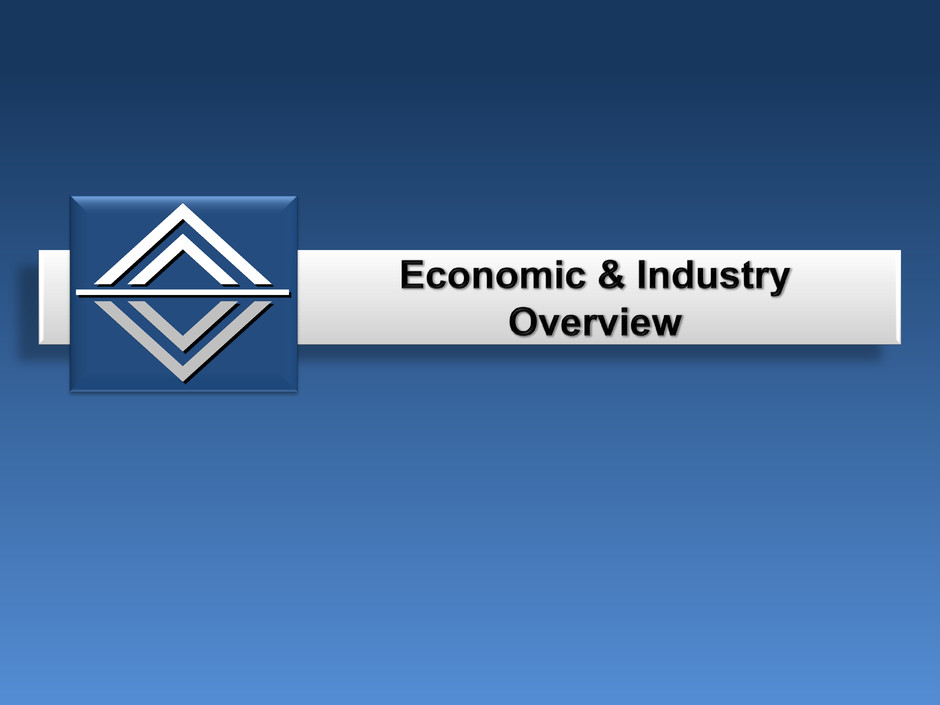
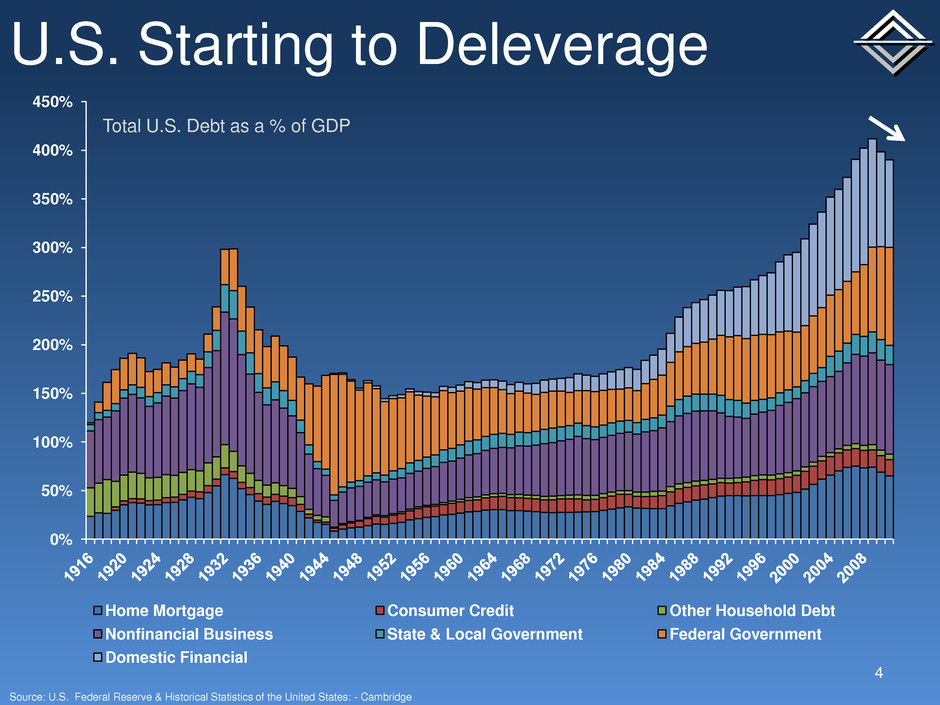
0% 50% 100% 150% 200% 250% 300% 350% 400% 450% Home Mortgage Consumer Credit Other Household Debt Nonfinancial Business State & Local Government Federal Government Domestic Financial U.S. Starting to Deleverage Total U.S. Debt as a % of GDP 4 Source: U.S. Federal Reserve & Historical Statistics of the United States: - Cambridge
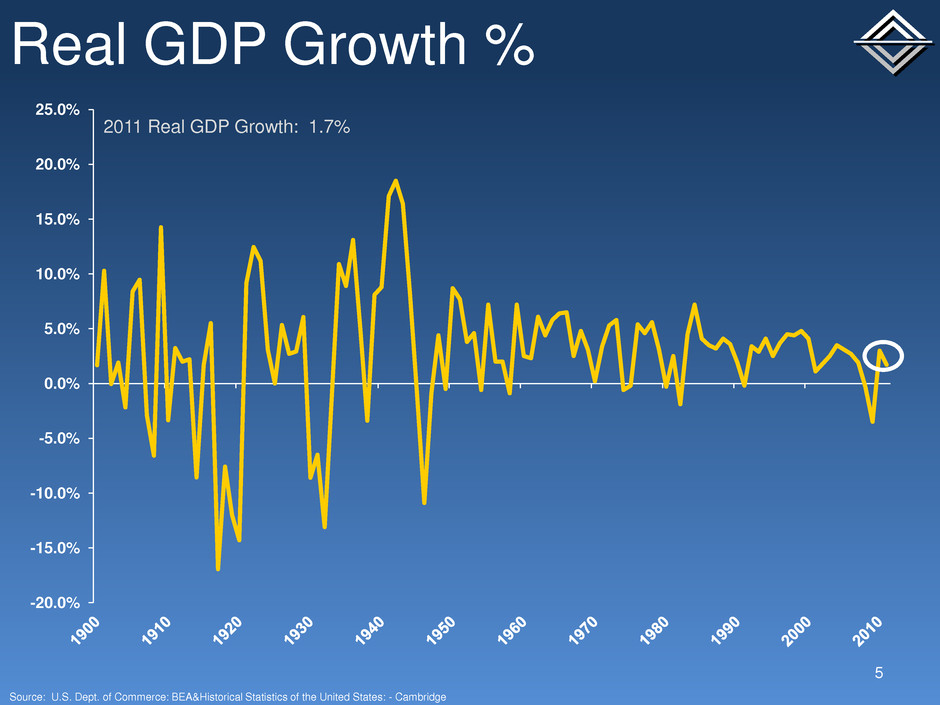
-20.0% -15.0% -10.0% -5.0% 0.0% 5.0% 10.0% 15.0% 20.0% 25.0% Real GDP Growth % 5 2011 Real GDP Growth: 1.7% Source: U.S. Dept. of Commerce: BEA&Historical Statistics of the United States: - Cambridge

-8.0 -6.0 -4.0 -2.0 0.0 2.0 4.0 6.0 8.0 10.0 Real GDP Growth Hotel Demand Growth Hotel Demand Driven by Economy Source: Smith Travel Research & U.S. Dept. of Commerce: BEA Hotel Demand Growth % vs. Real GDP Growth 6 R-squared = 0.61
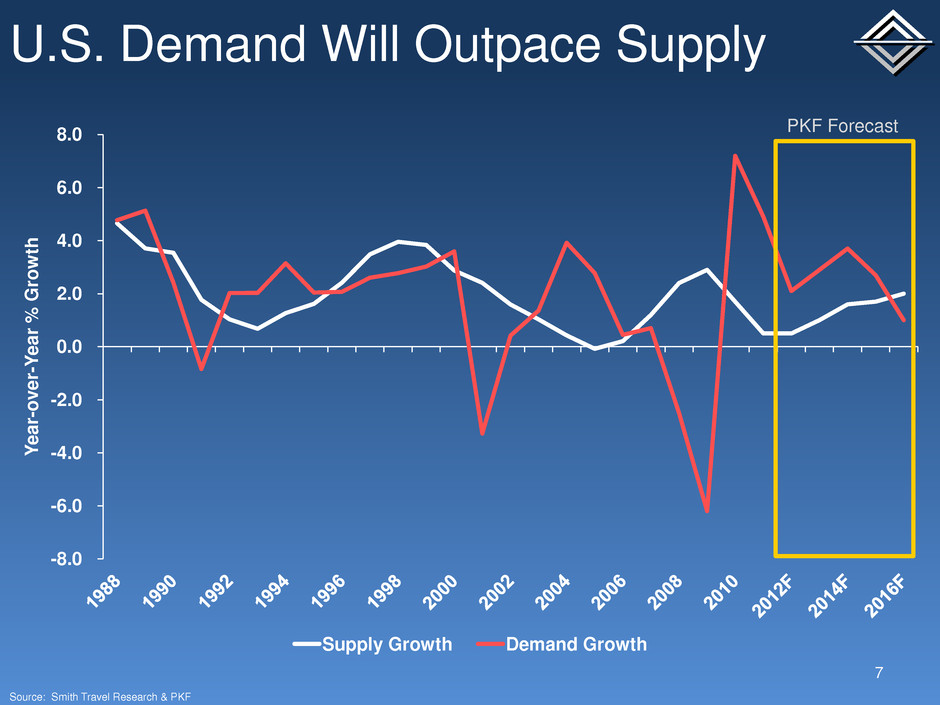
-8.0 -6.0 -4.0 -2.0 0.0 2.0 4.0 6.0 8.0 Y ea r- o v e r- Y ea r % G ro w th Supply Growth Demand Growth U.S. Demand Will Outpace Supply 7 PKF Forecast Source: Smith Travel Research & PKF
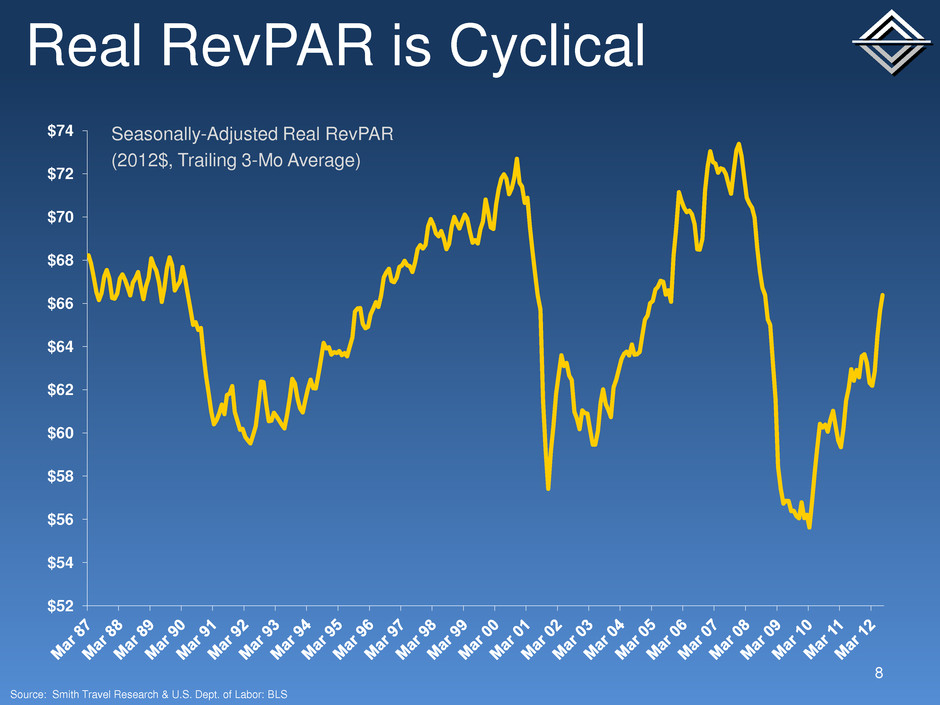
Real RevPAR is Cyclical Source: Smith Travel Research & U.S. Dept. of Labor: BLS Seasonally-Adjusted Real RevPAR (2012$, Trailing 3-Mo Average) 8 $52 $54 $56 $58 $60 $62 $64 $66 $68 $70 $72 $74
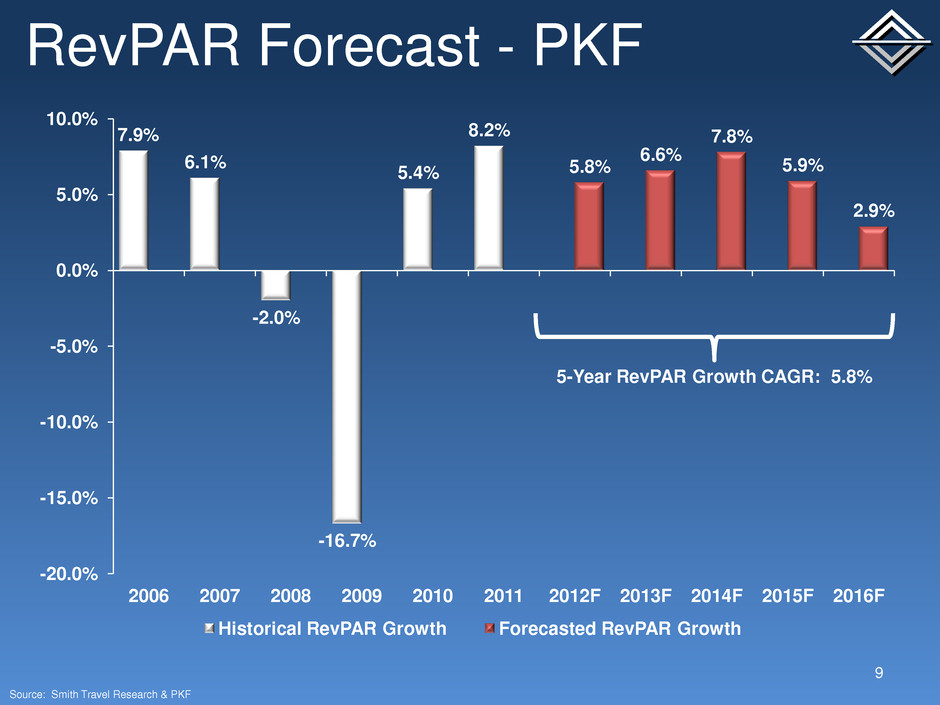
7.9% 6.1% -2.0% -16.7% 5.4% 8.2% 5.8% 6.6% 7.8% 5.9% 2.9% -20.0% -15.0% -10.0% -5.0% 0.0% 5.0% 10.0% 2006 2007 2008 2009 2010 2011 2012F 2013F 2014F 2015F 2016F Historical RevPAR Growth Forecasted RevPAR Growth RevPAR Forecast - PKF Source: Smith Travel Research & PKF 9 5-Year RevPAR Growth CAGR: 5.8%
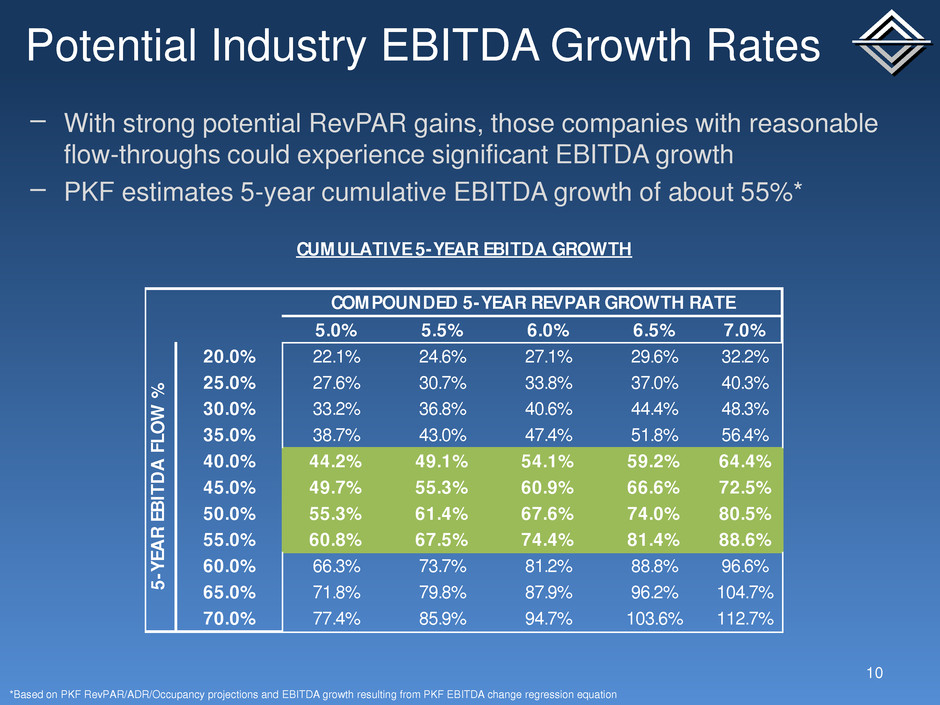
Potential Industry EBITDA Growth Rates 10 − With strong potential RevPAR gains, those companies with reasonable flow-throughs could experience significant EBITDA growth − PKF estimates 5-year cumulative EBITDA growth of about 55%* *Based on PKF RevPAR/ADR/Occupancy projections and EBITDA growth resulting from PKF EBITDA change regression equation COMPOUNDED 5-YEAR REVPAR GROWTH RATE 5.0% 5.5% 6.0% 6.5% 7.0% 20.0% 22.1% 24.6% 27.1% 29.6% 32.2% 25.0% 27.6% 30.7% 33.8% 37.0% 40.3% 30.0% 33.2% 36.8% 40.6% 44.4% 48.3% 35.0% 38.7% 43.0% 47.4% 51.8% 56.4% 40.0% 44.2% 49.1% 54.1% 59.2% 64.4% 45.0% 49.7% 55.3% 60.9% 66.6% 72.5% 50.0% 55.3% 61.4% 67.6% 74.0% 80.5% 55.0% 60.8% 67.5% 74.4% 81.4% 88.6% 60.0% 66.3% 73.7% 81.2% 88.8% 96.6% 65.0% 71.8% 79.8% 87.9% 96.2% 104.7% 70.0% 77.4% 85.9% 94.7% 103.6% 112.7% CUMULATIVE 5-YEAR EBITDA GROWTH 5- YE AR E BI TD A FL OW %
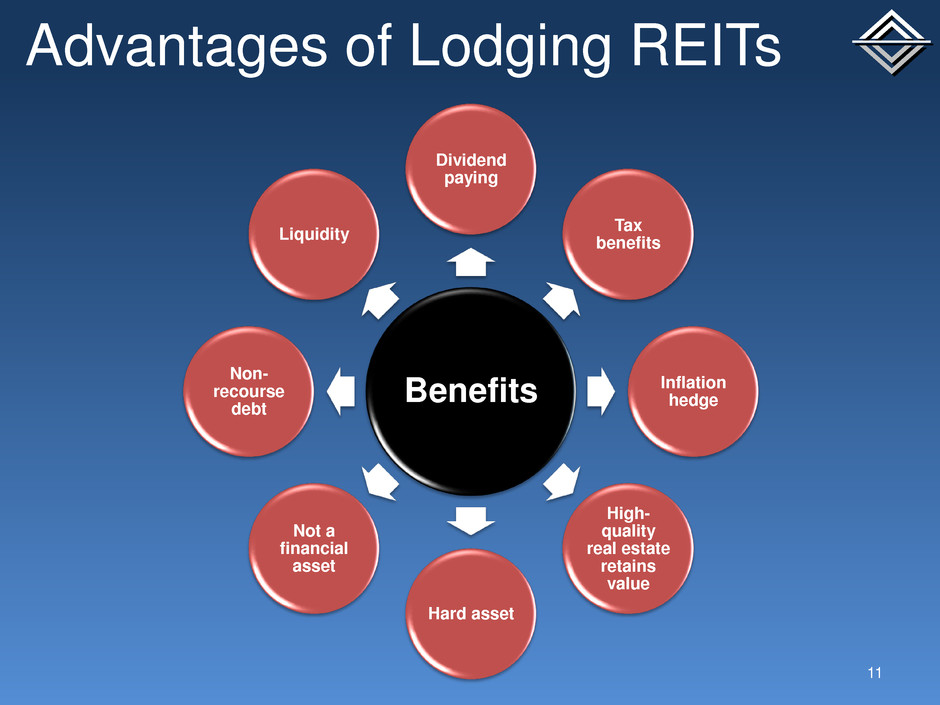
Advantages of Lodging REITs Benefits Dividend paying Tax benefits Inflation hedge High- quality real estate retains value Hard asset Not a financial asset Non- recourse debt Liquidity 11

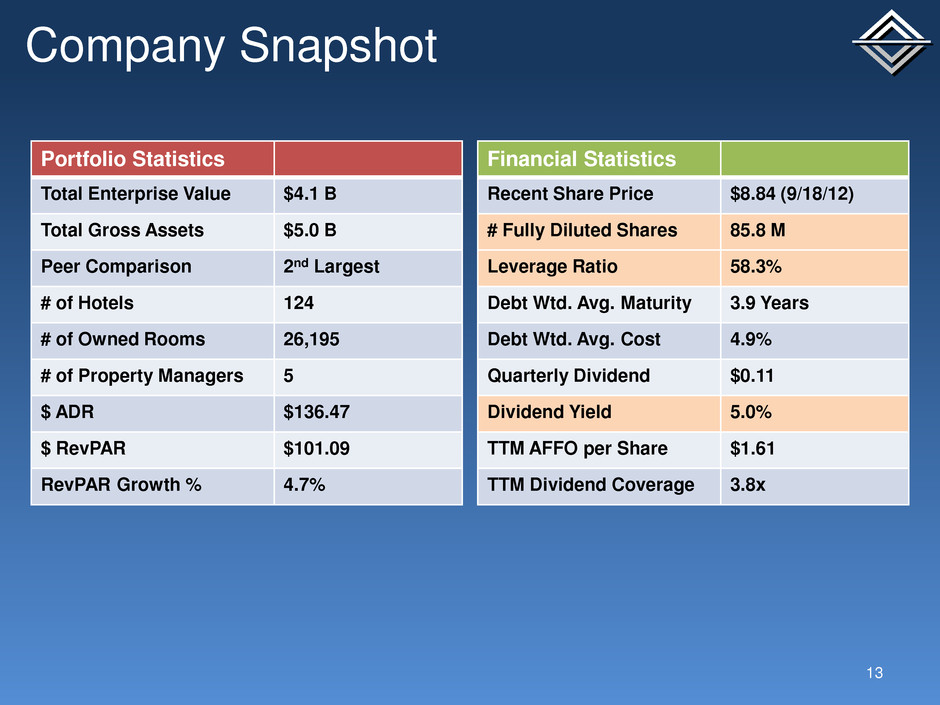
Company Snapshot 13 Portfolio Statistics Total Enterprise Value $4.1 B Total Gross Assets $5.0 B Peer Comparison 2nd Largest # of Hotels 124 # of Owned Rooms 26,195 # of Property Managers 5 $ ADR $136.47 $ RevPAR $101.09 RevPAR Growth % 4.7% Financial Statistics Recent Share Price $8.84 (9/18/12) # Fully Diluted Shares 85.8 M Leverage Ratio 58.3% Debt Wtd. Avg. Maturity 3.9 Years Debt Wtd. Avg. Cost 4.9% Quarterly Dividend $0.11 Dividend Yield 5.0% TTM AFFO per Share $1.61 TTM Dividend Coverage 3.8x

Attractive Dividend Yield & Coverage 14 − Ashford has both a high dividend yield and strong dividend coverage 5.6% 5.0% 4.3% 4.2% 3.1% 2.8% 2.6% 1.9% 1.6% - - - 1.6x 3.8x 1.6x 1.6x 2.2x 3.4x 2.6x 2.4x 4.4x - 0.5 1.0 1.5 2.0 2.5 3.0 3.5 4.0 4.5 5.0 0.0% 1.0% 2.0% 3.0% 4.0% 5.0% 6.0% 7.0% CLDT AHT HT CHSP DRH LHO Peer Avg PEB HST BEE FCH SHO A F F O C o v e ra g e D iv id e n d Y ie ld Dividend Yield (as of 9/18/12) TTM Q2 2012 AFFO Per Share Dividend Coverage Source: Company filings, Bloomberg & First Call

57% 25% 86% -6% -38% -36% -17% 2% 30% 8% 137% 146% 11% -2% 17% 50% -50% 0% 50% 100% 150% 200% 1-Yr 2-Yr 3-Yr 4-Yr 5-Yr 6-Yr 7-Yr 8-Yr Peer Avg. AHT Total Shareholder Return 15 Peer average includes: BEE, CHSP, CLDT, DRH, FCH, HST, HT, LHO, PEB, SHO Trailing Total Shareholder Returns as of 9/18/12 Source: Bloomberg
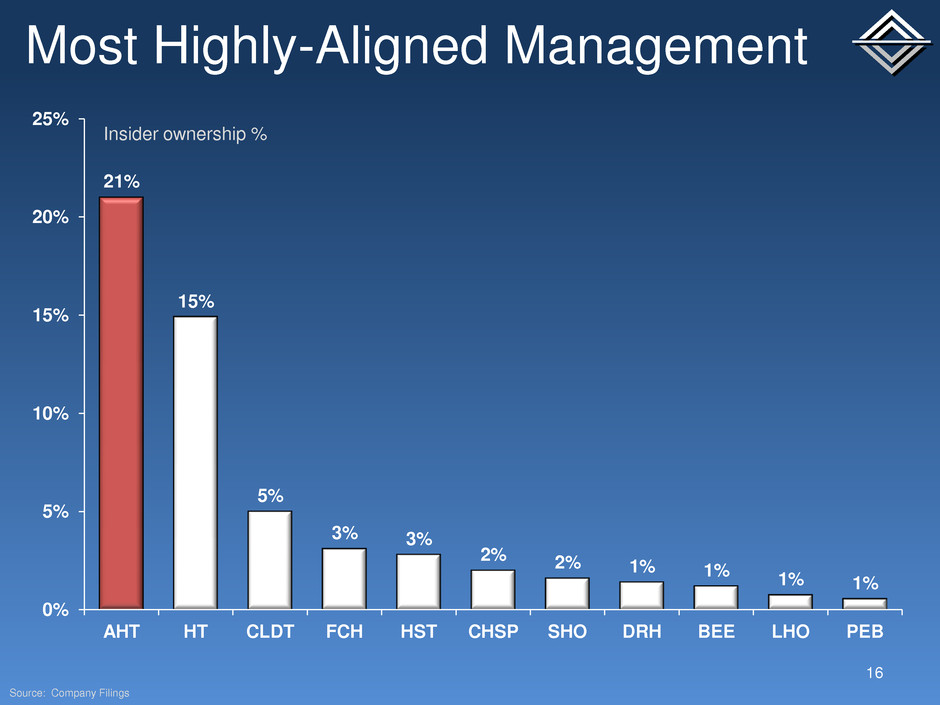
Most Highly-Aligned Management 16 21% 15% 5% 3% 3% 2% 2% 1% 1% 1% 1% 0% 5% 10% 15% 20% 25% AHT HT CLDT FCH HST CHSP SHO DRH BEE LHO PEB Insider ownership % Source: Company Filings

Upcoming Maturities & Debt Yields 17 − Upcoming maturities through 2014 include: − TTM June 2012 weighted average debt yields on these maturities are 13.6% Aareal Torrey Pines / Capital Hilton $143.7M Matures Aug 2013 13.5% TTM Debt Yield Highland Cigna Loans $101.4M Matures Jan-Apr 2013 17.2% TTM Debt Yield UBS Pool 1 $105.8M Matures Dec 2014 10.5% TTM Debt Yield GEMSA Manchester Courtyard $5.4M Matures May 2014 9.2% TTM Debt Yield
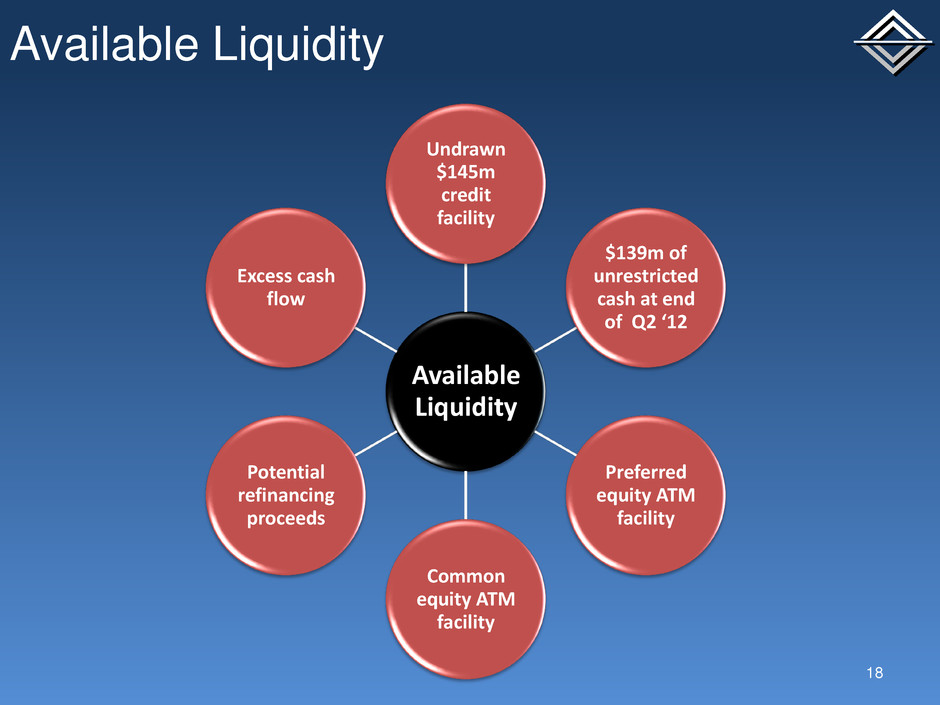
Available Liquidity 18 Available Liquidity Undrawn $145m credit facility $139m of unrestricted cash at end of Q2 ‘12 Preferred equity ATM facility Common equity ATM facility Potential refinancing proceeds Excess cash flow

Safety & Optionality 19 • Approximately 100-120% of equity value • ~$2.0 billion of debt • Positive cash flow • Weighted average maturity of 3.6 years • All debt non-recourse Portfolio A: Safety • Approximately 0-(20)% of equity value • $1.0 to $1.2 billion of debt • Positive cash flow • Weighted average maturity of 4.5 years • All debt non-recourse Portfolio B: Optionality & Upside
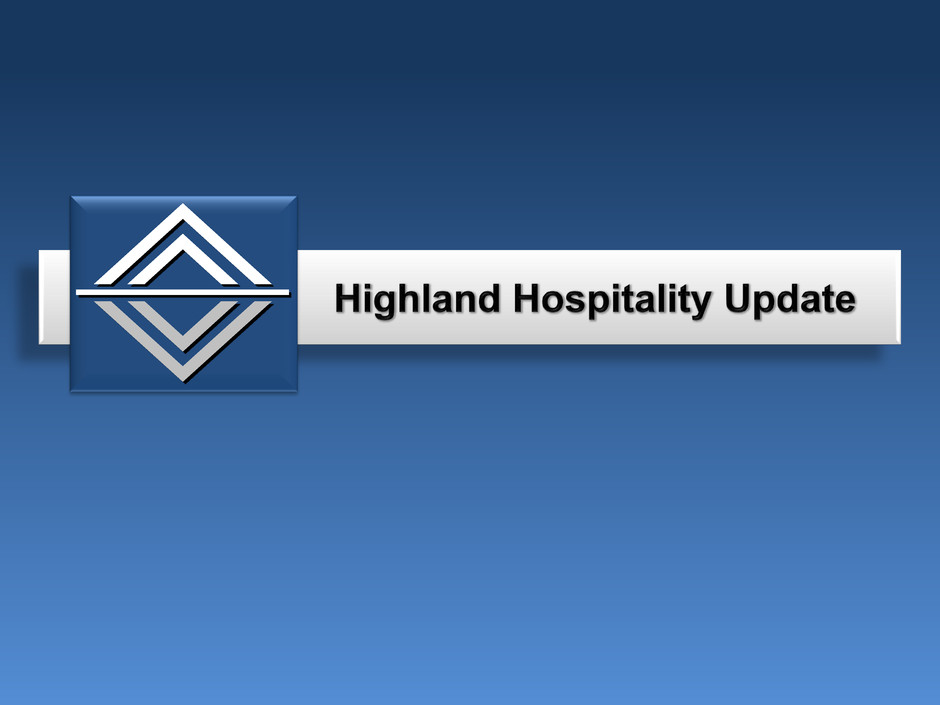

Highland Opportunities 21 Franchise properties • Looking for opportunities to create long-term value and operational efficiency through Remington management • Hilton Back Bay, Hyatt Windwatch, Courtyard Savannah & Residence Inn Tampa Operating flow throughs • Right-sizing the cost structure • Bringing best practices to operations Revenues • Rebuilding base business on the books • Stabilizing and growing RevPAR share Strategic Capex • Several of the properties had been neglected from a capital perspective • Revenues should benefit from capex
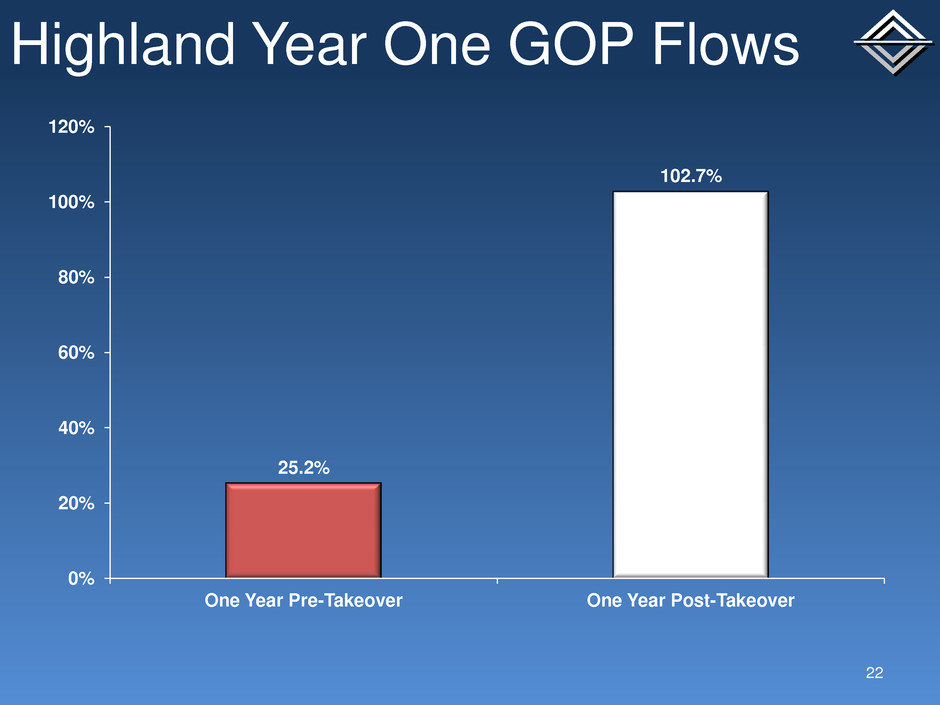
Highland Year One GOP Flows 22 25.2% 102.7% 0% 20% 40% 60% 80% 100% 120% One Year Pre-Takeover One Year Post-Takeover

Highland NOI Exceeds Underwriting 23 $79 $82 $86 $88 $91 $87 $72 $74 $76 $78 $80 $82 $84 $86 $88 $90 $92 Mar 2011 TTM Jun 2011 TTM Sep 2011 TTM Dec 2011 TTM Mar 2012 TTM U/W for Mar 2012 NOI $ (in m il lion s )

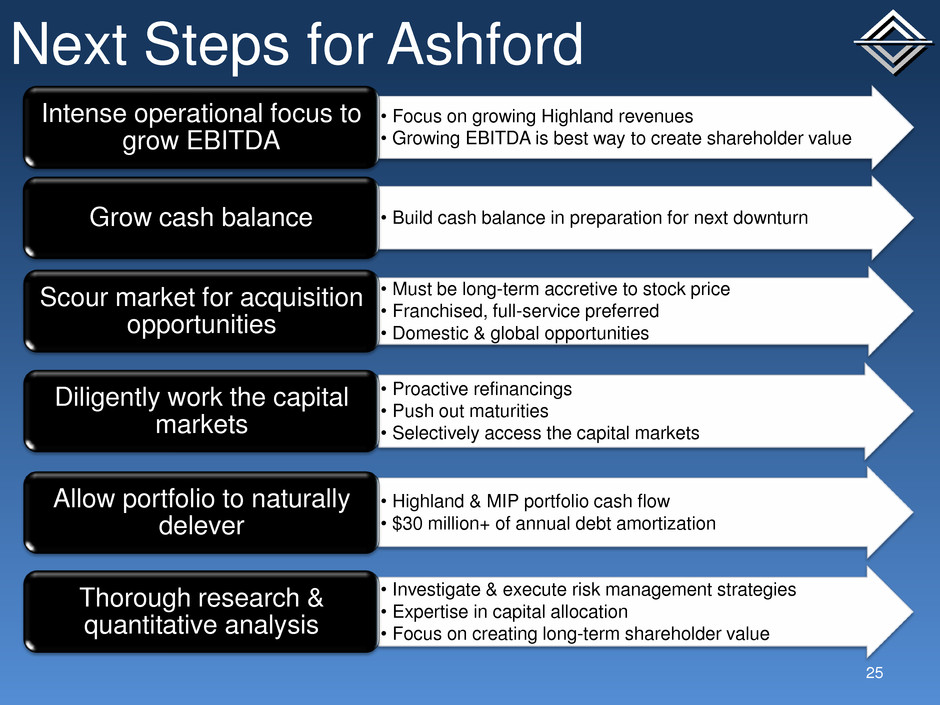
• Focus on growing Highland revenues • Growing EBITDA is best way to create shareholder value Intense operational focus to grow EBITDA • Build cash balance in preparation for next downturn Grow cash balance • Must be long-term accretive to stock price • Franchised, full-service preferred • Domestic & global opportunities Scour market for acquisition opportunities • Proactive refinancings • Push out maturities • Selectively access the capital markets Diligently work the capital markets • Highland & MIP portfolio cash flow • $30 million+ of annual debt amortization Allow portfolio to naturally delever • Investigate & execute risk management strategies • Expertise in capital allocation • Focus on creating long-term shareholder value Thorough research & quantitative analysis Next Steps for Ashford 25
